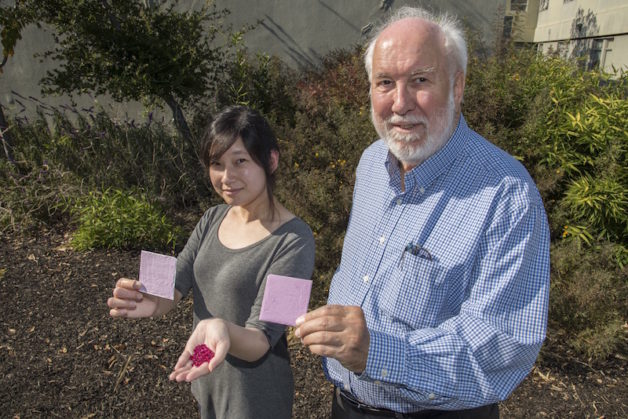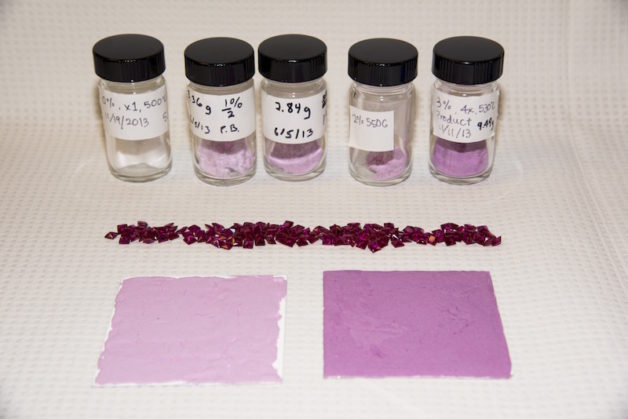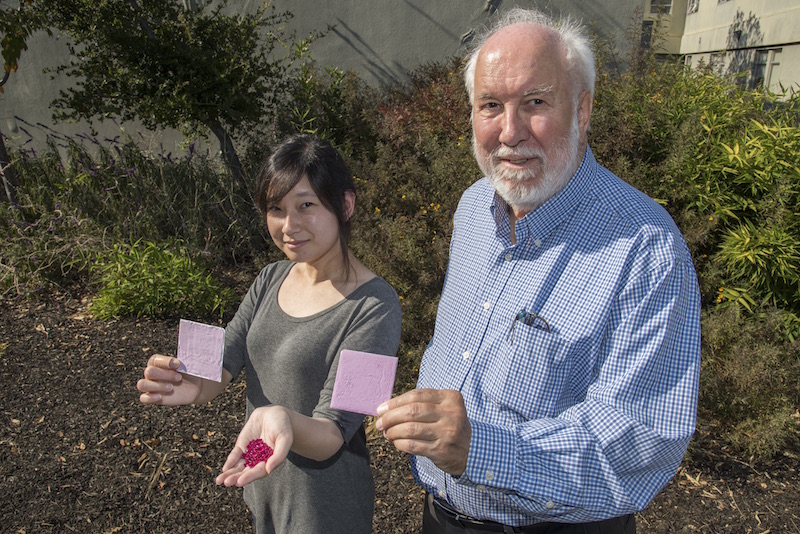
Berkeley Lab researchers Sharon Chen and Paul Berdahl hold up their prototype coating made from ruby powder and show synthetic ruby crystals used in early tests. (Credit: Marilyn Chung/Berkeley Lab)
Elementary school science teaches us that in the sun, dark colors get hot while white stays cool. Now new research from Lawrence Berkeley National Laboratory (Berkeley Lab) has found an exception: Scientists have determined that certain dark pigments can stay just as cool as white by using fluorescence, the re-emission of absorbed light.
The researchers tested this concept by coloring cool roof coatings with ruby red (aluminum oxide doped with chromium). Led by Berkeley Lab scientist Paul Berdahl, they first found that white paint overlaid with a layer of ruby crystals stayed as cool as a commercial white coating. Next, they synthesized ruby pigment to mix into coatings. Their results were published recently in the journal Solar Energy Materials & Solar Cells, in an article titled “Fluorescent cooling of objects exposed to sunlight—The ruby example.”
Substantial research over the years from Berkeley Lab’s Heat Island Group has found that reflective roofs and walls can cool buildings and cars. This reduces the need for air conditioning and mitigates the urban heat island effect. By reflecting the sun’s rays back to space, these cool materials also release less heat into the atmosphere, thus cooling the planet and offsetting the warming effects of substantial amounts of greenhouse gas emissions.
However, wider adoption of cool roofs has been hindered by aesthetic considerations. “We’ve heard many times (from roofing materials manufacturers), ‘We can’t sell white or pastel roofs; our customers want dark green, dark brown, and so on,’” Berdahl said.

Berkeley Lab researchers found a way to make ruby red coatings as cool as white coatings. (Credit: Marilyn Chung/Berkeley Lab)
Over the past 15 years, Heat Island Group researchers have used special pigments that strongly reflect invisible “near-infrared” light to make dark surfaces that stay cooler in the sun than conventional dark surfaces, though still not as cool as white surfaces. This new work shows that fluorescent cooling can boost the performance of these pigments by re-emitting at longer wavelengths some of the visible light that the surface must absorb to appear dark.
This opens the door to darker colors of not only cool roofs but of any object that is subject to prolonged periods of sun exposure, including vehicles, ships, storage tanks, and PVC piping. “We do think cars will be a likely application,” Berdahl said. “And it’s not just a matter of comfort or saving energy by avoiding AC use. We learned from colleagues that with electric vehicles, the battery lifetime is degraded by higher temperatures, so if you can keep the automobile cooler with use of a suitable coating then it extends the life of the battery.”
Using fluorescence, or photoluminescence, for cool materials is a new concept, and Berdahl, who is a physicist by training, has a patent pending on the technology. “People understand that materials that fluoresce are emitting energy,” he said. “What’s new here is the use of the fluorescence process to keep buildings cooler.”
When light hits a fluorescent material, the material actively emits energy in response, rather than passively reflecting the energy. Berdahl’s idea was to find a material that would absorb visible light and fluoresce (re-emit) mostly or entirely in the invisible near-infrared portion of the sun’s spectrum. “There have been thousands of fluorescent compounds identified,” he said. “Ruby’s properties are well known and well studied, and I realized it’s a material that could work.”
His first experiment was to use an array of synthetic ruby crystals, which he purchased online and said were surprisingly inexpensive. Attached to a bright white coating and exposed to bright sunlight, the dark-red ruby-covered coating stayed cooler than an off-white surface.
Berdahl and Berkeley Lab research associate Sharon Chen then synthesized ruby powder, or aluminum oxide, doped with varying amounts of chromium to create different shades of red pigment. They prepared ruby paint from the powders, and applied these paints over bright white substrates. When exposed to sunlight, the ruby paint samples stayed as cool as white materials.
“The ruby powder does need more work to make it as deep red as the ruby crystal,” Berdahl said.
If the product were to be commercialized, Berdahl said that the cost is not expected to be substantial and its durability is expected to be similar to other coatings. “Rubies have a reputation for being expensive, but they’re mostly aluminum oxide, which sells for about 70 cents per kilogram (or about 30 cents per pound),” he said.
PPG Industries, a Pittsburgh, Pennsylvania-based coating manufacturer also involved in the research, is conducting weathering tests with prototype fluorescent coatings.
In follow-up work Berdahl has identified blue materials that also fluoresce and showed that they can be combined with other colors to yield green and even black materials that stay cool.
The research was supported by the Department of Energy’s Office of Energy Efficiency and Renewable Energy (EERE). Additional funding was provided by the California Energy Commission. Co-authors of the paper were Sharon Chen, Hugo Destaillats, Thomas Kirchstetter, and Ronnen Levinson of Berkeley Lab, and Michael Zalich of PPG’s Coatings Innovation Center.
# # #
Lawrence Berkeley National Laboratory addresses the world’s most urgent scientific challenges by advancing sustainable energy, protecting human health, creating new materials, and revealing the origin and fate of the universe. Founded in 1931, Berkeley Lab’s scientific expertise has been recognized with 13 Nobel prizes. The University of California manages Berkeley Lab for the U.S. Department of Energy’s Office of Science. For more, visit www.lbl.gov.
DOE’s Office of Science is the single largest supporter of basic research in the physical sciences in the United States, and is working to address some of the most pressing challenges of our time. For more information, please visit science.energy.gov.
